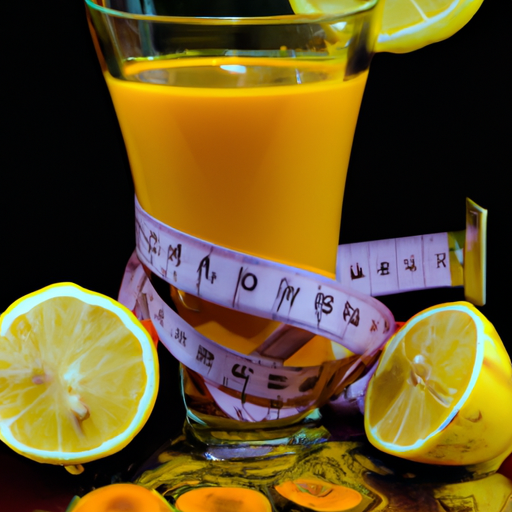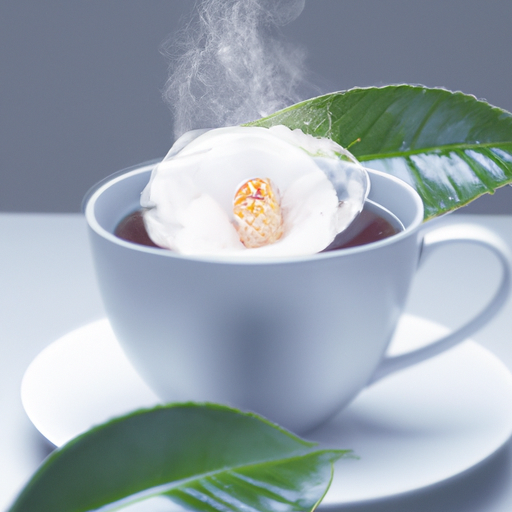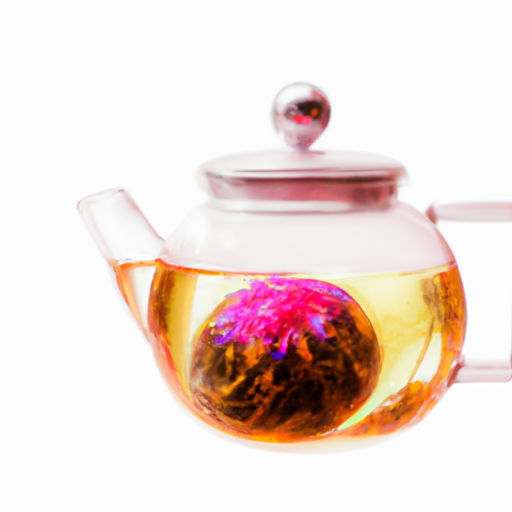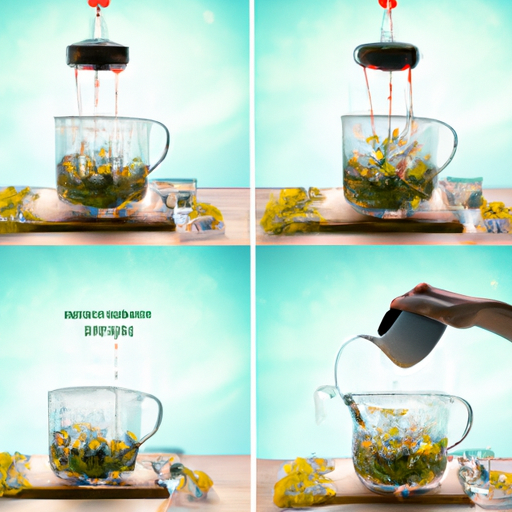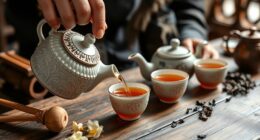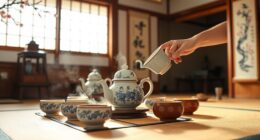Imagine a cup of tea that is not only a feast for your taste buds but also a visual delight. Enter butterfly pea flower tea, a stunning blue brew that is as mesmerizing as it is delicious. As an avid tea enthusiast, I have discovered the wonders of this unique flower and its ability to transform a simple cup of hot water into a vibrant concoction.
In this article, I will guide you through the process of making tea with butterfly pea flowers, step by step. From gathering the ingredients and equipment to steeping the flowers and adding the perfect touch of sweetness, I will share my knowledge and expertise to help you create a cup of tea that is not only beautiful but also packed with health benefits.
So, grab your tea kettle and let’s embark on this colorful tea journey together.
Key Takeaways
- Butterfly pea flower tea is visually appealing and can enhance the aesthetic appeal of tea preparation.
- Butterfly pea flowers offer numerous health benefits, including fighting free radicals, reducing oxidative stress, improving digestion, aiding in weight management, and promoting healthy hair and skin.
- Butterfly pea flower tea can be enjoyed on its own or used as a base for other teas and beverages, and can be flavored with lemon, honey, mint, ginger, lavender, or other ingredients.
- The vibrant blue color of butterfly pea flower tea comes from its rich anthocyanin content, which is a powerful antioxidant and has been linked to reducing inflammation and improving brain function.
Introduction to Butterfly Pea Flowers
The use of butterfly pea flowers enhances the overall aesthetic appeal of tea preparation. These vibrant blue flowers not only add a pop of color to your cup, but they also offer numerous health benefits.
Butterfly pea flowers can be used in various other beverages, such as cocktails and smoothies, to create visually stunning concoctions.
One of the most popular ways to use butterfly pea flowers is in the preparation of butterfly pea flower tea. This herbal tea is known for its striking blue hue, which is derived from the flowers’ natural pigments. To make butterfly pea flower tea, simply steep a handful of the flowers in hot water for a few minutes. The longer you steep, the deeper the blue color becomes.
Butterfly pea flower tea can be enjoyed on its own, but it can also be used as a base for other teas and beverages. For instance, you can add lemon juice to the tea to create a beautiful purple color, thanks to the tea’s pH-reactive properties. Additionally, you can experiment with different herbs and spices to create unique flavor combinations.
Now that you know the uses for butterfly pea flowers in other beverages and the basics of making butterfly pea flower tea, let’s move on to the next step: gathering the ingredients and equipment.
Gather the Ingredients and Equipment
To prepare this unique beverage, you’ll need to gather all the necessary ingredients and equipment. First, you’ll need butterfly pea flowers, which can be found in both dried and fresh forms. These vibrant blue flowers are the star of the show and will give your tea its distinctive color. You can also consider adding alternative ingredients like lemongrass or ginger for an extra kick of flavor.
In addition to the flowers, you’ll need a few basic kitchen tools. Firstly, a teapot or a large saucepan to boil the water and steep the flowers. Make sure it’s got a lid to keep the heat in. You’ll also need a heat source, such as a stove or an electric kettle, to bring the water to a boil. A strainer or a tea infuser will come in handy to separate the flowers from the liquid once the steeping’s complete.
Now that you’ve got all the equipment needed, it’s time to move on to the next step: boiling water and preparing the tea infusion.
Boil Water and Prepare the Tea Infusion
Once you have gathered all the necessary ingredients and equipment, you can begin by boiling water and crafting the exquisite infusion. Boiling water is an essential step in making tea with butterfly pea flowers, as it helps to release their vibrant blue color and delicate flavor. To boil water effectively, you can use a kettle or a pot on the stovetop. Fill it with the desired amount of water, depending on how many cups of tea you want to make. Bring the water to a rolling boil, which means that the bubbles are rapidly and consistently rising to the surface. Maintaining the right temperature is crucial, as boiling water can scorch the delicate petals of the butterfly pea flowers. Once the water is boiling, you can add the butterfly pea flowers and let them steep for a few minutes. This step allows the flowers to infuse their beautiful blue color and distinct taste into the water. After the infusion is complete, you can proceed to the next step of steeping the butterfly pea flowers, which will further enhance the flavor and hue of the tea.
Steep the Butterfly Pea Flowers
Steeping the butterfly pea flowers is like adding a splash of vibrant blue to your tea, transforming it into a work of art. To bring out the beautiful blue color and delicate flavor of the flowers, it’s important to follow the right steeping techniques.
Begin by bringing a pot of water to a boil. Once the water reaches a rolling boil, remove it from the heat and let it cool for a minute or two.
Next, add a handful of butterfly pea flowers to a tea infuser or a tea bag and place it in a teapot or a cup. Pour the hot water over the flowers, ensuring that they’re fully submerged. Let the flowers steep for about 5 to 10 minutes. The longer you steep, the deeper the blue color and the stronger the flavor will be.
As you steep the butterfly pea flowers, you might also consider their alternative uses. Apart from making tea, the flowers can be used to create natural dyes for textiles or even as a food coloring in various recipes.
Now that the flowers have steeped to perfection, it’s time to strain and sweeten the tea. This will remove any remaining flower petals or debris and allow you to adjust the sweetness according to your preference. So, let’s move on to the next step and enjoy the enchanting beauty of butterfly pea flower tea.
Strain and Sweeten the Tea
Now that you’ve steeped the enchanting butterfly pea flowers, it’s time to strain the tea and add a touch of sweetness to enhance your sipping experience.
Straining the tea is an essential step to remove any leftover flower petals or debris, ensuring a smooth and clear brew. There are several straining techniques you can use, such as using a fine mesh strainer or a tea infuser. Simply pour the steeped tea through the strainer into your cup, and watch as the vibrant blue liquid cascades down, ready to be enjoyed.
To elevate the flavor of your butterfly pea flower tea, consider adding a touch of sweetness. While traditional white sugar is a popular choice, there are also alternative sweeteners that can complement the tea’s unique taste. Options like honey, agave syrup, or stevia can provide a natural and healthier sweetness. Experiment with different amounts to find the perfect balance that suits your preference.
Now that you’ve strained and sweetened your butterfly pea flower tea, it’s time to take it a step further and experiment with flavor additions.
Experiment with Flavor Additions
To enhance your sipping experience, you can explore a myriad of delightful flavor additions that will elevate the already enchanting butterfly pea flower tea. By experimenting with different flavor combinations, you can create a unique and personalized tea that suits your taste preferences. Conducting taste tests with various ingredients can be a fun and exciting way to discover new and exciting flavors.
To help you get started, here is a table showcasing some flavor additions that pair well with butterfly pea flower tea:
| Flavor Addition | Description |
|---|---|
| Lemon | Adds a refreshing citrusy twist |
| Honey | Provides a natural sweetness |
| Mint | Adds a cool and refreshing element |
| Ginger | Adds a subtle, spicy kick |
| Lavender | Adds a floral and soothing note |
Feel free to mix and match these flavors or even try out your own combinations. The possibilities are endless!
Once you have completed your taste tests and found your favorite flavor combination, you can move on to the next section to serve and enjoy the vibrant blue tea. With these flavor additions, your butterfly pea flower tea will be even more delightful and satisfying.
Serve and Enjoy the Vibrant Blue Tea
Indulge in the vibrant blue elixir and relish in the enchantment of serving and savoring this captivating tea. Here are some creative ways to serve butterfly pea flower tea:
- Add a squeeze of lemon juice to watch the vibrant blue color transform into a beautiful purple hue.
- Freeze the tea into ice cubes and use them to add a pop of color to your favorite beverages.
- Mix it with sparkling water for a refreshing and effervescent drink.
- Use butterfly pea flower tea as a natural food coloring agent in baking or cooking.
- Create stunning layered drinks by combining the tea with other colorful ingredients like fruit juices or coconut milk.
The significance of the vibrant blue color in butterfly pea flower tea lies in its rich anthocyanin content. Anthocyanins are powerful antioxidants that’ve been linked to numerous health benefits, including reducing inflammation and improving brain function.
Transitioning into the subsequent section about the health benefits of butterfly pea flower tea, it’s important to note that the vibrant blue color is just the beginning. This tea not only captivates with its visual appeal but also holds a wealth of health-enhancing properties.
Health Benefits of Butterfly Pea Flower Tea
Immerse yourself in the world of wellness as you discover the myriad health benefits waiting to unfurl with every sip of this enchanting elixir. Butterfly pea flower tea not only delights the senses with its vibrant blue color, but it also offers a range of health benefits.
Packed with antioxidants, this tea helps fight free radicals and reduce oxidative stress, promoting better overall health. It’s also known to improve digestion, aiding in weight management and alleviating bloating. Additionally, the tea has been found to support healthy hair and skin, thanks to its high content of flavonoids and anthocyanins.
To maximize the health benefits of butterfly pea flower tea, it’s important to master the right brewing techniques. Steeping the flowers in hot water for around five minutes allows the vibrant blue color and beneficial compounds to infuse into the tea. You can enhance the flavor and health benefits by adding a squeeze of lemon juice or a dash of honey.
As you delve into the world of butterfly pea flower tea, you’ll soon discover that its enchanting properties extend beyond the teacup. Explore the next section to learn about the other uses for butterfly pea flowers and unlock their full potential in your wellness journey.
Other Uses for Butterfly Pea Flowers
Discover the endless possibilities that await when you harness the extraordinary versatility of butterfly pea flowers. These beautiful blue blossoms aren’t just for making tea, but can also be used in a variety of other ways.
Here are some exciting uses for butterfly pea flowers:
-
Skincare: The natural pigment in butterfly pea flowers can be used to create stunning blue dyes that are safe for the skin. You can make your own natural blue face mask or add the flowers to your bath for a relaxing and rejuvenating experience.
-
Culinary uses: Butterfly pea flowers aren’t only visually appealing but also add a unique flavor to dishes. You can infuse them into syrups, sauces, or even cocktails for a vibrant blue hue. They can also be used to naturally color rice or desserts, giving them a stunning blue tint.
-
Natural dye: The vibrant blue color of butterfly pea flowers can be extracted and used as a natural dye for fabrics, yarns, or even paper. Create beautiful and eco-friendly creations with this all-natural dye.
-
Herbal remedies: Butterfly pea flowers have long been used in traditional medicine for their potential health benefits. They’re believed to have antioxidant properties and can be used to make herbal teas or tinctures.
Now that you’ve discovered the various uses for butterfly pea flowers, let’s dive into some tips and tricks for brewing the perfect cup of butterfly pea flower tea.
Tips and Tricks for Brewing the Perfect Cup of Butterfly Pea Flower Tea
Get ready to elevate your tea brewing game with these essential tips for creating the perfect cup of butterfly pea flower tea. Brewing butterfly pea flower tea requires some special techniques to fully enjoy its unique color-changing properties.
To start, make sure to use fresh, high-quality butterfly pea flowers. The flowers should have a vibrant blue color and a fragrant aroma. You can find them at specialty tea shops or order them online.
For the brewing process, use hot water that’s around 180°F (82°C) to 200°F (93°C). Steep the flowers in the hot water for about 5 to 7 minutes, or until the water turns a deep blue hue. If you want a stronger flavor, you can steep it for a longer period of time.
To enhance the flavor and color, you can add a squeeze of lemon juice or a splash of citrusy fruit juice. This’ll not only give the tea a tangy taste but also transform its color from blue to purple or pink.
Remember to use a clear glass or cup to fully appreciate the mesmerizing color-changing effect. And if you want to impress your guests, you can serve the tea with a garnish of fresh butterfly pea flowers or a slice of lemon.
With these brewing techniques, you can now enjoy the perfect cup of butterfly pea flower tea and amaze your friends with its stunning color-changing properties.
Frequently Asked Questions
Can butterfly pea flowers be used to make tea with any other type of tea leaves?
Yes, butterfly pea flowers can be used to make tea with various other types of tea leaves. This combination allows for alternative brewing methods and opens up a world of unique flavor profiles. When steeped together, the vibrant blue hues of the butterfly pea flowers infuse into the tea, creating a visually stunning experience. The resulting brew not only offers a visually appealing cup of tea but also a delightful and refreshing taste.
How long does it take for butterfly pea flowers to steep?
Butterfly pea flowers usually take about 5-10 minutes to steep. Steeping time can vary depending on personal preference and desired strength of the tea. During steeping, the vibrant blue color of the flowers infuses into the water, creating a visually stunning drink.
Besides its beautiful appearance, butterfly pea flower tea has numerous health benefits, such as being rich in antioxidants and having potential anti-inflammatory properties. To enhance the flavor, you can add a squeeze of lemon or honey.
What are the different health benefits of butterfly pea flower tea?
Drinking butterfly pea flower tea can have numerous health benefits, especially for mental health. This magical tea is known to boost cognitive function and improve memory, making it a perfect natural remedy for mental fatigue and stress.
Additionally, its vibrant blue color adds a touch of whimsy to culinary creations, making it a popular ingredient in cocktails, desserts, and even savory dishes. So, not only does butterfly pea flower tea have mental health benefits, but it also has versatile culinary uses.
Are there any known side effects or allergies associated with butterfly pea flower tea?
I’m knowledgeable about the side effects and allergies of butterfly pea flower tea, as well as its potential interactions with medications.
It’s important to note that there aren’t any known side effects or allergies associated with butterfly pea flower tea. However, as with any herbal tea, it’s always advisable to exercise caution if you have any known allergies to flowers or plants.
Additionally, if you’re taking any medications, it’s recommended to consult with your healthcare provider before consuming butterfly pea flower tea to rule out any potential interactions.
Can butterfly pea flowers be used to make cold tea or iced tea?
When it comes to making tea with butterfly pea flowers, it’s important to note that they can indeed be brewed with hot water instead of cold water. This allows for a quicker infusion process, resulting in a vibrant blue color. However, brewing with hot water tends to yield a slightly more intense flavor compared to when it’s brewed with cold water. The taste, in both cases, is known for its earthy and slightly floral notes.
Conclusion
In conclusion, making tea with butterfly pea flowers is a simple and enjoyable process that yields a vibrant blue drink with numerous health benefits. Although some may argue that the tea’s flavor is too mild, it can easily be enhanced by adding sweeteners or combining it with other herbal teas.
So don’t let the potential mildness deter you from trying this unique and visually stunning beverage. Give it a try and experience the wonders of butterfly pea flower tea for yourself.
Cheers to good health and delightful tea!


